10 “In our arts we find our bliss”
Posted by Christine on Sep 14, 2014 in Ireland | 7 comments
Sometime before the end of the ninth century, an Irish monk wrote a poem comparing the art of writing to the art of a cat—Pangur Bán—catching a mouse:
I and Pangur Bán, my cat,
‘Tis a like task we are at;
Hunting mice is his delight,
Hunting words I sit all night.
The poem celebrates artistry, not just for the results it produces, but also for the satisfaction and meaning, even transcendence, creation affords the artist. After noting the many parallels between catching a mouse and “Turning darkness into light” through writing, the poet concludes
So in peace our tasks we ply,
Pangur Bán, my cat, and I;
In our arts we find our bliss,
I have mine and he has his.
When I study the stone carvings at Jerpoint Abbey in Thomastown, Co. Kilkenny—a place I am drawn to visit again and again—I am reminded of this layered definition of craftsmanship with its humane insight and its tone of wry humor. The artists who created the knights and ladies, saints and bishops, and other creatures at Jerpoint surely found their “bliss” in this work.
Jerpoint is a Cistercian monastery founded in the twelfth century with continued building over the next several centuries until the 1540s, when wealthy monastic settlements in Britain and Ireland were attacked by Henry VIII’s forces in his efforts to consolidate power in his new church. In the care of the government since 1880, the abbey has been extensively restored and is one of the best examples of its kind in Ireland. Still surrounded by countryside as it has always been, the abbey is a reminder that with their religious communities, churches, artisans, lay dependents, and educational centers, monasteries were the towns of medieval Ireland.
Carvings of religious and secular figures, real and mythical animals, and patterned borders decorate the tombs, walls, arches, and the colonnade in the reconstructed cloister. The sheer number and exuberance of the carvings at Jerpoint and their placement throughout the buildings tell us something about the nature of religious belief in this multigenerational community and also about the artistry of the carvers. Even today, six or seven hundred years later, their skill, vision, humanity, and love of their work are evident in every line.
Take this row of saints carved on a tomb, for example: St. Catherine with her wheel, Michael the Archangel carrying a soul to heaven, and St. Margaret with her cross plunged into the dragon’s stomach. The images are both stylized and individual, allegorical and personal.
The three faces look the same on first glance, but each takes on personality as you study it further. When I’m at Jerpoint I am transfixed in their presence. For one thing, in spite of their considerable travails, they’re all smiling. What do those smiles mean? They remind me of the wry humor in Pangur Bán and other monastic poems, a humor that perhaps even amounts to a subtle expression of existential attitude. I could imagine any one of these saints offering “a lake of beer to God” to see “all the heavenly saints tippling there” (St. Brigid’s Prayer). Perhaps the smile conveys a contemporaneous notion of piety, an interpretation offered by my friend Donna Sadler, a scholar of medieval religious sculpture. All the better. Piety embodied in the ease of a smile could embrace compassion, the veiled origin of the most penetrating humor.
Of course it’s impossible to know—if fun to imagine—what people were thinking so long ago, what cultural practices or conventions were in play, what rules and fears pervaded. No doubt the artist or artists were working within ecclesiastical conventions and further constrained by the qualities of their stone and their tools, but their artistic vision prevails.
Probably my favorite image from Jerpoint Abbey is the carving of the so-called “Ormond Knight” on the colonnade at the west wall of the cloister. A portrait of a noble from the Butler family, the knight is somewhat comical in appearance, his body proportions distorted—perhaps in order to fit him into the space allowed—and his helmet askew, looking as if it had been bashed in a few times. Peering somewhat wistfully from behind the metal flanges, the knight seems heartbreakingly real, someone forced to play a role he really doesn’t want to play, perhaps. And what about the monkey at his right elbow, carved separately as an afterthought? Was it a family symbol associated with the Butlers, dukes of Ormond? A favorite pet? Or did the artist add the image of a monkey to convey a meaning we can no longer decipher? Maybe because the oddities of this carving tell a story, I am drawn to the Ormond Knight and visit him first and last when I come to Jerpoint.
In the abbey church there’s a flat carving—a large etched slab— now mounted on a wall, but probably once the lid of a tomb, of two knights who are thought to be brothers and probably fell at the same battle. The placement of the entwined bodies, the turn of the heads, the detailed depiction of hands and feet suggests a mother’s grief at burying her two sons. The formal qualities of the piece are softened by the individuality of the subjects. The care lavished on carving the knights’ spurs seems surprising, but on my most recent visit the guide told me how important they were to dating the image; apparently spur fashion changed often and was relatively well documented. I can imagine the artist taking time to get the details right in this poignant image.
Along with the striking humanity and individuality of the many stone carvings, there are other things about Jerpoint that make it such a compelling place. Enough of the walls, colonnades, and the Romanesque and Gothic arches still exist to suggest the arrangement and interplay of the abbey’s public and private spaces. Almost anywhere you stand, the shadows and perspectives draw you into imagining the past. But every time I visit, I go back and spend more time with the saints and bishops, the knights and ladies, the dragons and griffins, even the flowers and lozenges that decorate the church but that also speak for the artists who made them.

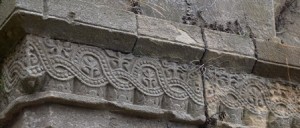
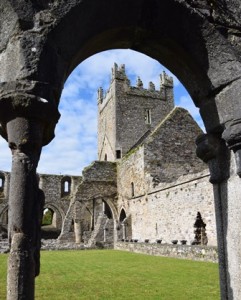
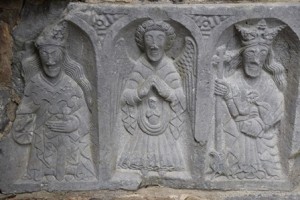
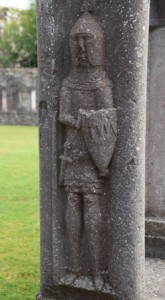
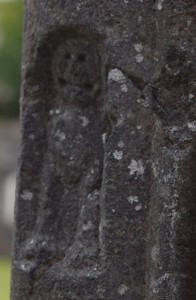
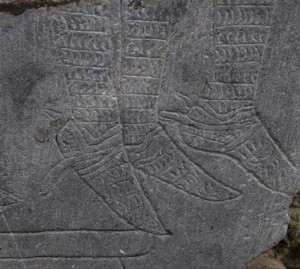
Lovely! Enjoying traveling vicariously with you!
Thank you! I’m excited that you are getting married and have enjoyed your blog on the subject.
Just reading the words as you present them transport me to the places that you describe so eloquently. So informative, and interesting. The pictures are amazing.Its a wonderful journey that I don’t have to leave home to enjoy.
Thanks Martha! Great to know you are out there.
Thanks for the wonderful post.
reading this post gives me a clearer sense of all that one can find in stone carvings. My looking now will include more seeing- certainly more seeing of the artists.
I know a griffin who would like to spend some time there imagining…. I was particularly pulled in by this line: “Piety embodied in the ease of a smile could embrace compassion, the veiled origin of the most penetrating humor.” Maybe because we are so in need of a compassionate humor. Reading your contemplative and informed posts are a respite. Thank you. -Kathi